Therapeutic Theatrics
Seattle’s largest circus school provides psychotherapy through social circus
By Jaya Flanary

In the back of a Kindergarten classroom, Katrina Hayes sits alone after her teacher moved her desk for being disruptive. As a child, she was medicated for attention deficit hyperactivity disorder.
Katrina was bullied for her appearance — she has an African American father and white mother, but has pale skin. She struggled with her identity and felt out of place, out of control, not wanted and “too much,” which affected her relationships.
As a teenager, she found acceptance at The School of Acrobatics and New Circus Arts in Seattle (SANCA), which was founded by her pediatric nurse practitioner, Jo Montogomery.
“The idea of running away and joining the circus was always very alluring,” Katrina said. “It’s a place where no one really judges you for being different because the circus is full of misfits.”
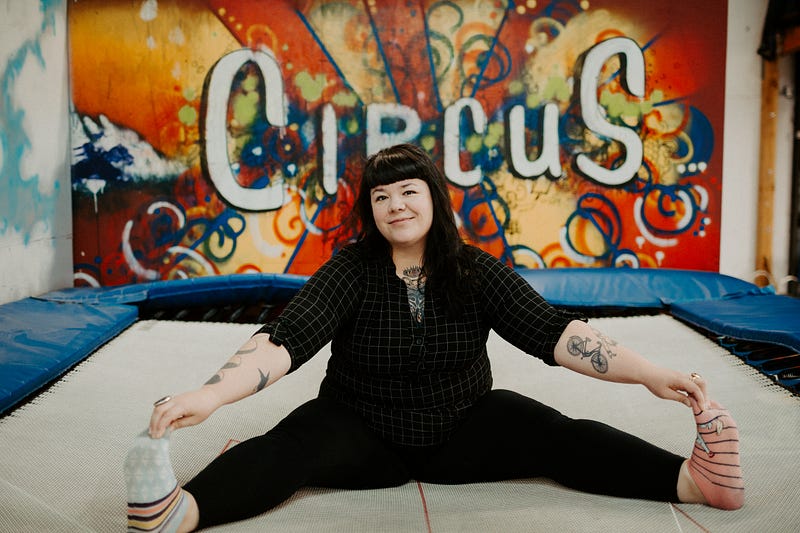
Years later, magic happens when Amber Parker, a psychotherapist and self-titled “fatcrobat” at SANCA, meets Sarah Wells-Ikeda, a clown with theater experience and a background in psychology.
In 2016, the school hired Amber to create a new program called Transformational Women’s Circus. With a background in women’s health, Amber worked towards her master’s in Marriage and Family Therapy at Antioch University Seattle.
Amber made Transformational Women’s Circus her thesis in 2018 while studying the intersection between circus, somatics and therapy. Sarah was brought on as a co-facilitator during the second year.
Together, the two women investigated drama therapy, play therapy and psychotherapy. The program was incorporated into SANCA’s social circus program, alongside Every Body’s Circus.
“This is a very different way to do circus,” Amber said. “It really challenges normative ideas of what it means to be an athlete.”
[embed]https://youtu.be/TKOoYRqcOc8[/embed]
Students integrate the parts of themselves that they feel ashamed of as parts of the whole, Sarah said, a concept she learned at the Institute of Transpersonal Psychology.
This idea is clinically called trauma integration, Amber said. It is essentially healing, the program’s ultimate goal. Instead of carving out what makes us suffer, we must bring it closer in order to move forward.
“We’re not here to heal you because inherently you don’t need to be fixed,” Sarah said. “There’s not anything wrong with the way that you are, but there are parts of yourself that need to be integrated for you to make more empowered choices in your life.”
Amber explained how therapy emphasizes activation and brings out a traumatic response, be it anger, distress, emotional dysregulation, or crying.
“Activation is another way of talking about triggering,” Amber said. “It’s not that we’re looking for opportunities to trigger them, we just know that we will and we accept that.”
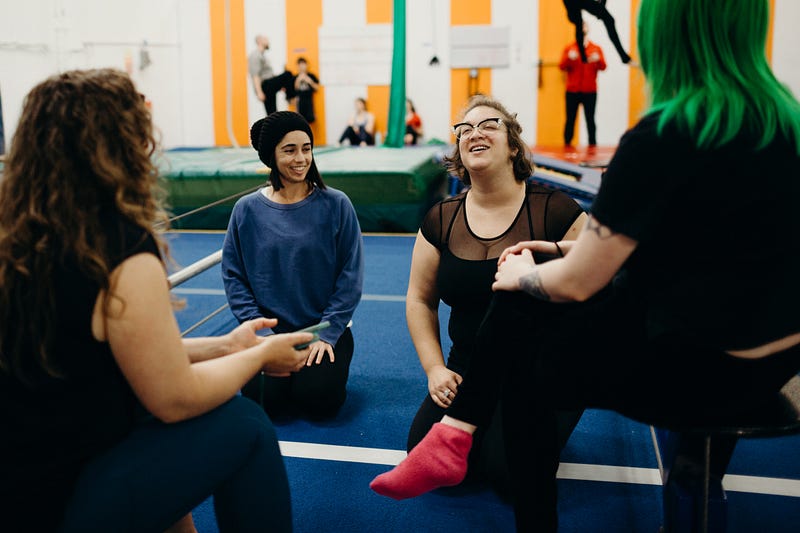
Conventional talk therapy, though helpful when setting goals, does not dive deep into integration and healing. The program’s therapy provides symptom reduction and alleviates suffering. Students address family of origin and complex themes like child abuse, so past participation in therapy is required.
“Movement opens the door to the soul, to history and to your feelings about your body,” Amber said. “When you marry them, all of a sudden, through much hard work, you have this integrated creative arts therapy.”
The program works on four levels: body, mood, relation and avoidance, which all help the students’ nervous systems tolerate stress rather than avoid it. The program also regulates students’ limbic systems — rewiring the brain through psychodrama — and relates it all using drama therapy in order to repattern unhealthy patterns.
Each cohort is made up of eight to twelve female-identifying people who have the desire to improve their overall wellbeing and mental health. Those interested in joining can fill out an application. Financial assistance is available and accepted applicants will join the third cohort in January 2020.
“I think that women find this program at a very particular point in time, and it’s when they’re ready to really confront things,” Sarah said.
Katrina was one of these women. While looking for a therapist as an adult, she found Transformational Women’s Circus and thought it was meant to be, because it combines trauma-focused therapy work with an activity she loves.
SANCA’s grey warehouse is tucked away in Georgetown’s industrial neighborhood, but the inside is full of life, color and movement.
People climb ropes and silks that hang from the ceiling, others stretch in circles on mats. Toddlers tumble and bounce through an obstacle course, and Katrina calls them fearless. All the thumping and thudding resembles childhood gymnastics.
“I want to get in there and do cartwheels with them real bad,” Katrina said, eager to move around. In the other room, she hops up on the tightwire platform barefoot. She starts to walk, holding her arms out for balance, then falls. Laughing, she begins again.
Katrina loves tightwire because it requires concentration, as well as awareness of her body and alignment. She compares it to finding balance in her life and gaining confidence, rather than letting the voice in her head tear her down.
This concept led to Katrina’s inner critic wire walk act for the first cohort’s performance to showcase the 24-week program. During the piece, the group acts as a machine, calling out Katrina’s inner thoughts:
You’re too much, you’re not good enough, nobody likes you.
“I was able to walk across the wire fine because I’m used to hearing those things in my own head,” Katrina said. “But then the machine flipped and started saying affirmative things like, ‘You belong! You’re wanted! You’re loved!’ I totally broke down. It didn’t feel like those words should be for me.”
The alumni group is evolving Katrina’s piece for the school’s Annual Showcase Spectacular, which highlights recent student and staff work for donors. As a nonprofit, the school relies on donations to continue their goal of “serving students from all economic backgrounds,” according to their website.
The group huddles up and plans the movements on paper. They incorporate a large stick into the piece, which Katrina holds while her peers stand at her sides. Yelling negative comments, they pull the stick back and forth, affecting Katrina’s balance.
“Instead of falling into those old patterns, how are we showing up for ourselves and our lives now and really changing that narrative?” Katrina said. “I still have a negative voice in my head [saying] ‘nobody wants to work with you.’ It doesn’t just go away.”
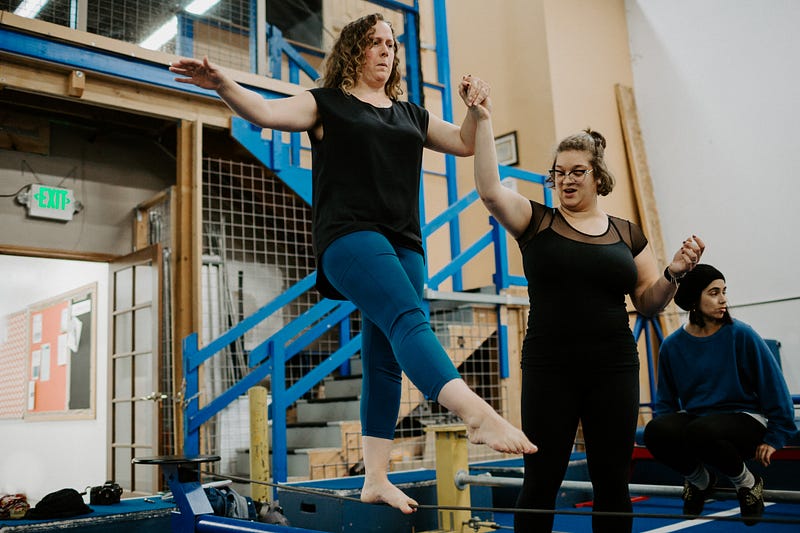
During the first cohort, Amber noticed Katrina address her inner criticism and move through the program’s full cycle, reaching a massive symptom reduction.
“When I intaked Kat, I could see that she was a woman with complex traumatic stress disorder,” Amber said. “She’s been through a lot of intersecting traumas in her life.”
The program uses a triadic session format and each class works on a bell curve. Part one regulates the nervous system through activities that bond the group, creating relaxation and a sense of safety.
Part two involves intervention, which is trauma-focused, and relies heavily on the facilitators having an established relationship with the students. “Bring them to a peak where their nervous systems are aroused, but they’re not dysregulated,” Amber said. “In other words, they’re not in fight or flight or freeze.”
Part three is integration — making meaning of it all and leaving students feeling safe and loved. During the first six weeks, they focus on building relationships, which involves a lot of play and whimsy, such as running around and growling like animals.
According to the National Institute For Play, “The existing research describes patterns and states of play and explains how play shapes our brains, creates our competencies, and ballasts our emotions.”
“Play is not a kid thing,” Amber said. “It’s a human thing.”
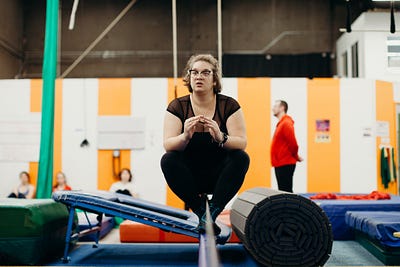
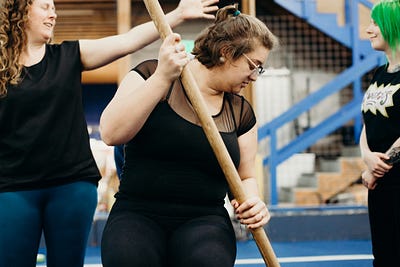
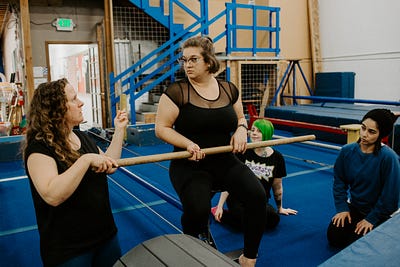
Next, they practice psychodramatic techniques — deep emotional work — which is counterbalanced with learning complex circus skills. Circus coach Emma Curtiss works with students during this time.
“She has a really awesome way of getting through to women, getting women to feel confidence, getting women to feel small parts of their bodies that might be hard to access,” Sarah said. “Circus can hurt, so in a certain way, we’re exposing them to safe pain.”
Amber and Sarah recount memorable moments, such as a student reenacting child abuse. They asked her what she wanted her mother to say, which was, “I love and accept you just as you are.”
So each troupe member said that to her.
“Watching her cry through that,” Amber said, tearing up, “that created such a huge change for her. It was awesome to watch her blossom after that moment.”
According to Sarah, everyone’s inner child is in the room interacting with one another.
“A lot of us had to grow up really fast,” Sarah said. “Having to leave behind any sort of childhood or the ability to be a child, we lose connection to our bodies. We lose connection to our joy. We lose connection to the ability to have a sense of wonder and awe about the world around us.”
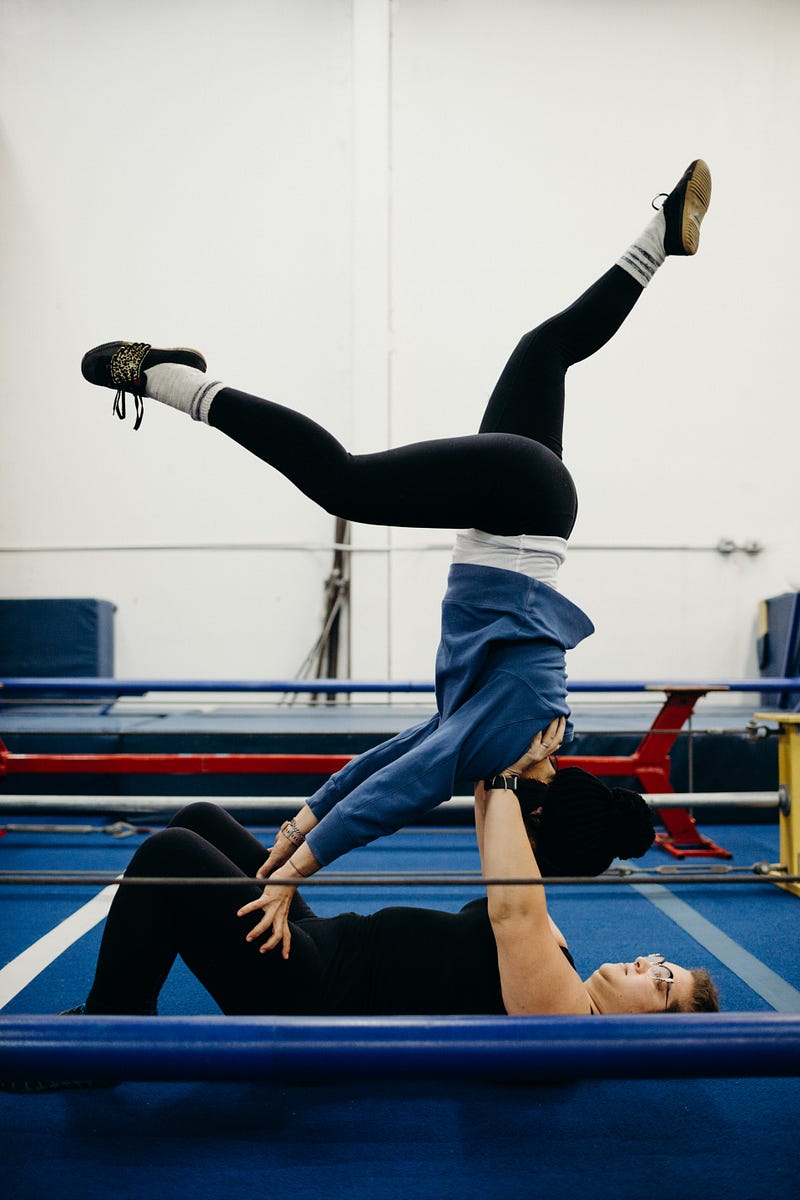
During the second cohort, Sarah asked the students to prepare a short segment for a group talent show. One woman came completely unprepared. Sarah told her she still needed to perform anyway, even if she just stood there and cried. The woman ended up telling a story about performing on stage as a kid and how that terrified her.
Sarah described the woman’s performance piece as earth shattering. “It was literally an act where other members of the cohort had her bound in ropes and fabric and she was just breathing through to an extremely angry song,” Sarah said.
Students leave the class with a reduction in depression and anxiety symptoms, as well as an increase in self-efficacy, self-confidence and acceptance of themselves. They’re able to name and express their needs as well as tolerate the vulnerability of doing so.
“Every woman we’ve had has been an over functioner,” Amber said. “Women are socialized to over function and to function for everyone in their lives. It’s toxic and it degrades their sense of self.”
Social circus is gaining awareness and research. A study in Finland found that social circus “has obvious effects on wellbeing” and that “psychological effects are reported primarily by those who have problems tolerating failure and with self-esteem.”
Amber is in touch with similar programs being pioneered throughout the world, including BUST! in New Mexico, Vulcana in Australia, and some start-ups in New Zealand and England. She has also presented circus as therapy at the Smithsonian Folklife Festival and is featured in magazines.
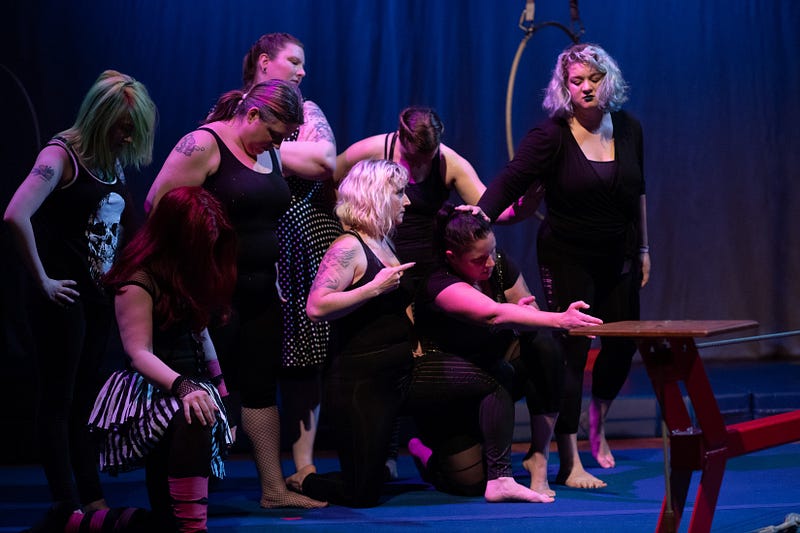
Transformational Women’s Circus allowed Katrina to be in her body and interact with others playfully in a safe space. She doesn’t have to tone herself down and she never feels like “too much” at The School of Acrobatics and New Circus Arts in Seattle.
“Do you want to hang upside down for fun?,” Katrina asks her peers in a British accent. The alumni group moves to another room where other students and staff practice for the November show. The performances vary, from interpretive dance to static trapeze.
Katrina looks at circus apparatuses on Instagram, then swings her legs up on the trapeze to try them out. The women take turns helping each other, spotting each other and cheering each other on.
“I always say that Amber saved my life,” Katrina said. “But no, she gave me the tools I already had to save my own life.”
